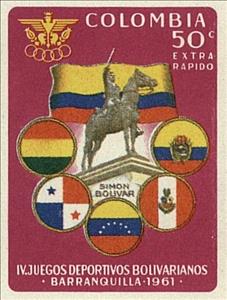Stamp: Simon Bolivar Statue - Flags (Colombia 1961)
Simon Bolivar Statue - Flags (Colombia 1961)
16 December (Colombia ) within release Bolivarian Games, Barranquilla 1961, 4th Ed. goes into circulation Stamp Simon Bolivar Statue - Flags face value 50 Colombian centavo
| Stamp Simon Bolivar Statue - Flags in catalogues | |
|---|---|
| Michel: | Mi: CO 1005 |
| Stamp Number: | Sn: CO C419a |
| Leo Temprano: | Lt: CO HF25c |
Stamp is vertical format.
Express air mail stamp for domestic use. Stamp from souvenir sheet MI BL25. Inscribed EXTRA RAPIDO. The IV Bolivarian Games were a multi-sport event held between December 3–16, 1961, at the Estadio Municipal in Barranquilla, Colombia. The Games were organized by the Bolivarian Sports Organization (ODEBO). Bolivia was the only eligible country not to send a delegation. Athletes from 5 countries were reported to participate in 14 sports.Also in the issue Bolivarian Games, Barranquilla 1961, 4th Ed.:
- Stamp - Simon Bolivar Statue - Flags face value 50;
- Stamp - Basketball face value 1;
- Stamp - Football / Soccer face value 1;
- Stamp - Baseball face value 50;
Stamp Simon Bolivar Statue - Flags it reflects the thematic directions:
A flag is a piece of fabric (most often rectangular or quadrilateral) with a distinctive design that is used as a symbol, as a signaling device, or as decoration. The term flag is also used to refer to the graphic design employed, and flags have since evolved into a general tool for rudimentary signalling and identification, especially in environments where communication is similarly challenging (such as the maritime environment where semaphore is used). National flags are patriotic symbols with varied wide-ranging interpretations, often including strong military associations due to their original and ongoing military uses. Flags are also used in messaging, advertising, or for other decorative purposes. The study of flags is known as vexillology, from the Latin word vexillum, meaning flag or banner.
The horse (Equus ferus caballus) is one of two extant subspecies of Equus ferus. It is an odd-toed ungulate mammal belonging to the taxonomic family Equidae. The horse has evolved over the past 45 to 55 million years from a small multi-toed creature, Eohippus, into the large, single-toed animal of today. Humans began to domesticate horses around 4000 BC, and their domestication is believed to have been widespread by 3000 BC. Horses in the subspecies caballus are domesticated, although some domesticated populations live in the wild as feral horses. These feral populations are not true wild horses, as this term is used to describe horses that have never been domesticated, such as the endangered Przewalski's horse, a separate subspecies, and the only remaining true wild horse. There is an extensive, specialized vocabulary used to describe equine-related concepts, covering everything from anatomy to life stages, size, colors, markings, breeds, locomotion, and behavior.
A monument is a type of structure that was explicitly created to commemorate a person or event, or which has become relevant to a social group as a part of their remembrance of historic times or cultural heritage, due to its artistic, historical, political, technical or architectural importance. Examples of monuments include statues, (war) memorials, historical buildings, archaeological sites, and cultural assets. If there is a public interest in its preservation, a monument can for example be listed as a UNESCO World Heritage Site. The Palgrave Encyclopedia of Cultural Heritage and Conflict gives the next definition of monument:
Sport is a form of physical activity or game. Often competitive and organized, sports use, maintain, or improve physical ability and skills. They also provide enjoyment to participants and, in some cases, entertainment to spectators. Many sports exist, with different participant numbers, some are done by a single person with others being done by hundreds. Most sports take place either in teams or competing as individuals. Some sports allow a "tie" or "draw", in which there is no single winner; others provide tie-breaking methods to ensure one winner. A number of contests may be arranged in a tournament format, producing a champion. Many sports leagues make an annual champion by arranging games in a regular sports season, followed in some cases by playoffs.
A statue is a free-standing sculpture in which the realistic, full-length figures of persons or animals are carved or cast in a durable material such as wood, metal or stone. Typical statues are life-sized or close to life-size. A sculpture that represents persons or animals in full figure, but that is small enough to lift and carry is a statuette or figurine, whilst those that are more than twice life-size are regarded as colossal statues.





